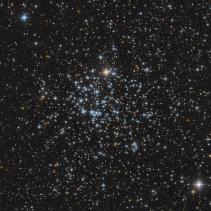Star clusters
M 39
Open Cluster M39 (also known as Messier Object 39, Messier 39, M39, or NGC 7092) is an open cluster in the constellation Cygnus. It was discovered by Charles Messier in 1764. M39 is at a distance of about 800 light-years away from Earth. Its age is estimated to be from 200 to 300 million years.
It is located at Right Ascension 21 hours, 32.2 minutes, and Declination +48 degrees 26 minutes.
It has a magnitude (brightness) of 5.5
R = 10 * 600 sec. bin1, G = 10 * 690 sec. bin1, B = 10 * 780 sec. bin1.
Pixinsight 1.8, Photoshop, eXcalibrator.
M 56
Messier 56 (also known as M56 or NGC 6779) is a globular cluster in the constellation Lyra. It was discovered by Charles Messier on January 19, 1779. The cluster is located almost midway along an imaginary line between Albireo (β Cygni) and Sulafat (γ Lyrae). It is a challenge to find with large (50–80 mm) binoculars, appearing as a slightly fuzzy star. The cluster can be resolved using a telescope with an aperture of 8 in (20 cm) or larger.
M56 is at a distance of about 32,900 light-years from Earth and measures roughly 84 light-years across, with a combined mass some 230,000 times that of the Sun. It is about 31–32 kly (9.5–9.8 kpc) from the Galactic Center and 4.8 kly (1.5 kpc) above the galactic plane. This cluster has an estimated age of 13.70 billion years and is following a retrograde orbit through the Milky Way. The properties of this cluster suggest that it may have been acquired during the merger of a dwarf galaxy, of which Omega Centauri forms the surviving nucleus. For Messier 56, the abundance of elements other than hydrogen and helium, what astronomers term the metallicity, has a very low value of [Fe/H] = –2.00 dex. This is equivalent to 1% of the abundance in the Sun.
R = 10 * 600 sec. bin1, G = 10 * 690 sec. bin1, B = 10 * 780 sec. bin1.
Pixinsight 1.8, Photoshop.
M 29
Messier 29 (also known as M 29 or NGC 6913) is an open cluster in the Cygnus constellation. It was discovered by Charles Messier in 1764, and can be seen from Earth by using binoculars.
The star cluster is situated in the highly crowded area of Milky Way near Gamma Cygni, at a distance of 7,200 (most sources including Mallas/Kreimer and Burnham, and agreeing with early estimates or R.J. Trumpler 1930) or 4,000 light years (the latter from Kenneth Glyn Jones and the Sky Catalogue 2000.0). The Night Sky Observer's Guide by Kepple and Sanner gives a deviating value of 6,000 light years – the uncertainty due to inaccurately known absorption of the cluster's light.
According to the Sky Catalog 2000, M29 is included in the Cygnus OB1 association, and approaching us at 28 km/s. Its age is estimated at 10 million years, as its five hottest stars are all giants of spectral class B0. The Night Sky Observer's Guide gives the apparent brightness of the brightest star as 8.59 visual magnitudes. The absolute magnitude may be an impressive -8.2 mag, or a luminosity of 160,000 Suns. The linear diameter was estimated at only 11 light years. Its Trumpler class is III,3,p,n (as it is associated with nebulosity), although Götz gives, differently, II,3,m, and Kepple/Sanner gives I,2,m,n. The Sky Catalogue 2000.0 lists it with 50 member stars; earlier Becvar gave only the number of 20 members.
R = 11 * 600 sec. bin1, G = 11 * 690 sec. bin1, B = 11 * 780 sec. bin1, Ha = 23 * 1800 sec. bin1.
Total exposition - 17.8 hours.
Pixinsight 1.8, Lightroom.
M 52
Messier 52 (also known as M52 or NGC 7654) is an open cluster in the Cassiopeia constellation. It was discovered by Charles Messier in 1774. M52 can be seen from Earth with binoculars.
Due to interstellar absorption of light, the distance to M52 is uncertain, with estimates ranging between 3,000 and 7,000 light years. One study identified 193 probable members of the cluster, with the brightest member being magnitude 11.
Messier 52 is evaluated at about 35 million years old.
R = 12 * 300 sec. bin1, G = 12 * 300 sec. bin1, B = 12 * 300 sec. bin1
Pixinsight 1.8, Lightroom.




